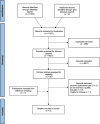Quality indicators for opioid stewardship interventions in hospital inpatient and emergency departments: a systematic review
- PMID: 40538554
- PMCID: PMC12178301
- DOI: 10.1097/PR9.0000000000001284
Quality indicators for opioid stewardship interventions in hospital inpatient and emergency departments: a systematic review
Abstract
A systematic review was conducted to identify existing quality indicators for opioid stewardship in hospital inpatient and emergency departments. Five databases (MEDLINE, Embase, CINAHL, CENTRAL, and Scopus) and grey literature were searched up to April 2022 to identify articles containing quality indicators for opioid stewardship in the hospital setting. Quality indicators were classified into (1) structure, (2) process, and (3) outcome according to Donabedian model and further analysed as subgroups. Risk of bias assessment was performed by 2 independent reviewers. In total, 4621 articles were identified after duplicates were removed, of which 20 full-text articles were screened for eligibility and 8 articles included in the review. There were 81 quality indicators extracted, of which 49 were unique quality indicators. Analysis produced 25% (12/49) structure, 61% (30/49) process, and 14% (7/49) outcome quality indicators. These quality indicators may be used to developed future quality standards, although further study is needed to improve patient data collection for outcome quality indicators to allow for more holistic evaluation of opioid stewardship programs.
Keywords: Emergency department; Hospitals; Inpatient; Opioid; Pain management; Prescribing.
Copyright © 2025 The Author(s). Published by Wolters Kluwer Health, Inc. on behalf of The International Association for the Study of Pain.
Conflict of interest statement
The authors have no conflict of interest to declare.Sponsorships or competing interests that may be relevant to content are disclosed at the end of this article.
Figures
Similar articles
-
Interventions to improve antibiotic prescribing practices for hospital inpatients.Cochrane Database Syst Rev. 2017 Feb 9;2(2):CD003543. doi: 10.1002/14651858.CD003543.pub4. Cochrane Database Syst Rev. 2017. PMID: 28178770 Free PMC article.
-
The educational effects of portfolios on undergraduate student learning: a Best Evidence Medical Education (BEME) systematic review. BEME Guide No. 11.Med Teach. 2009 Apr;31(4):282-98. doi: 10.1080/01421590902889897. Med Teach. 2009. PMID: 19404891
-
Comparison of cellulose, modified cellulose and synthetic membranes in the haemodialysis of patients with end-stage renal disease.Cochrane Database Syst Rev. 2001;(3):CD003234. doi: 10.1002/14651858.CD003234. Cochrane Database Syst Rev. 2001. Update in: Cochrane Database Syst Rev. 2005 Jul 20;(3):CD003234. doi: 10.1002/14651858.CD003234.pub2. PMID: 11687058 Updated.
-
The measurement and monitoring of surgical adverse events.Health Technol Assess. 2001;5(22):1-194. doi: 10.3310/hta5220. Health Technol Assess. 2001. PMID: 11532239
-
Taxane monotherapy regimens for the treatment of recurrent epithelial ovarian cancer.Cochrane Database Syst Rev. 2022 Jul 12;7(7):CD008766. doi: 10.1002/14651858.CD008766.pub3. Cochrane Database Syst Rev. 2022. PMID: 35866378 Free PMC article.
References
-
- Awadalla R, Gnjidic D, Patanwala A, Sakiris M, Penm J. The effectiveness of stewardship interventions to reduce the prescribing of extended-release opioids for acute pain: a systematic review. Pain Med 2020;21:2401–11. - PubMed
-
- Black N, Jenkinson C. Measuring patients' experiences and outcomes. BMJ 2009;339:b2495. - PubMed
Publication types
LinkOut - more resources
Full Text Sources
Miscellaneous

